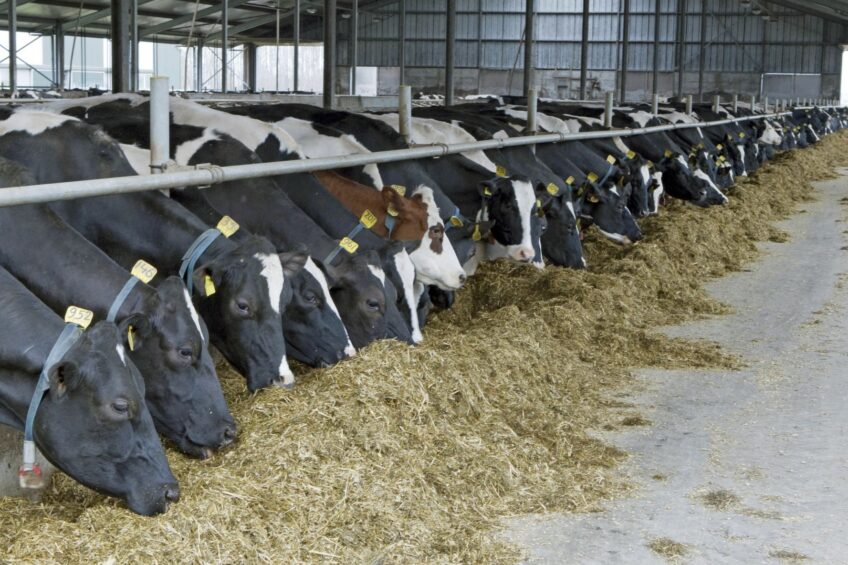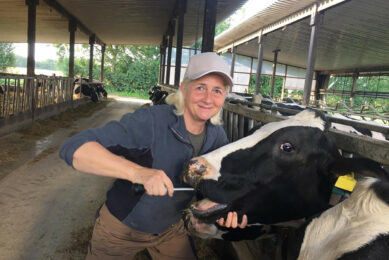Maximising energy use for optimal dairy cow performance

Energy is one of the most critical nutrient requirements for ruminants, especially dairy cows, where it represents one of the most limiting factors in dairy diets. Energy plays a fundamental role in the synthesis of milk components such as fat, protein, and lactose. Ensuring that cows can use energy efficiently is vital for their optimal performance, herd profitability, and for reducing their environmental footprint.
The more efficient a cow can convert energy from feed into energy for milk production, the lower the feed costs and the lower the environmental impact. An energy-deficient diet significantly reduces milk solids production as well as milk yield.
What drives energy use and efficiency?
Dairy cows derive their energy from their diet, primarily composed of carbohydrates, which typically make up 60–70% of the cow’s intake. The main source of energy for cows comes from volatile fatty acids (VFAs) produced by the microbes in their rumen. The three key VFAs – acetate, butyrate, and propionate – are responsible for providing 50% to 85% of the cow’s metabolizable energy.
The role of volatile fatty acids
The balance of VFAs significantly impacts energy efficiency. For example:
• Acetate: Mostly contributes to milk fat synthesis.
• Butyrate: Provides energy through c4-c16 molecules and supports rumen wall health.
• Propionate: The most energy efficient VFA as it acts as a precursor to glucose, essential for both energy utilisation and milk production through lactose.
VFAs result from fermenting carbohydrates, including sugars, starch, and fibre. However, the balance of these components is crucial to maintaining rumen health and ensuring efficient energy use.
• Sugars and quick-starch are rapidly broken down in the rumen, producing VFAs quickly. While these can help increase energy availability, too much starch can lead to rapid fermentation, lactic acid build-up, and rumen acidosis, and therefore can have a negative effect on energy efficiency and overall rumen stability.
• Fibre is broken down more slowly and steadily, providing a sustained release of VFAs.
Balancing the diet is essential. Too much starch can lead to an unstable rumen environment, while too little reduces microbial activity, negatively impacting both digestion and energy efficiency. Additionally, excessive fat intake can suppress appetite and alter milk composition.
Propionate: key to efficient energy use
Among the VFAs, propionate stands out as the most energy efficient. It acts as a glucose precursor and plays a pivotal role in converting energy from feed into milk. By promoting propionate production, energy use can be maximised, leading to more efficient milk production.
Role of the small intestine
Not all carbohydrates are fermented in the rumen. A portion escapes fermentation and flows into the small intestine, where it contributes to energy through nutrient digestion and absorption. For instance, starch that avoids rumen digestion is broken down and absorbed in the small intestine, providing glucose directly to the cow.
The small intestine is also the absorption centre for many other nutrients. In particular, the intestinal crypts are the site of intense nutrient absorption. Increasing the capacity of absorption is also a way to improve efficiency.
Improving energy efficiency in dairy cows
Energy efficiency can be improved by selecting the right raw materials and by balancing the diet. Feed quality impacts digestibility and nutrient availability. The harder a cow’s digestive tract must work to extract nutrients from the feed, the less energy efficient it is. Feed quality also impacts the ratios of the various VFAs produced in the rumen, and this alters the precursors for fat synthesis.
One of the most effective strategies to improve energy efficiency in dairy cows is to shift rumen fermentation towards producing more propionate and less acetate. This can be achieved by selecting the right balance of raw materials in the cow’s diet.
• Starch degradability: Choosing feed ingredients that increase propionate production in the rumen, such as degradable starch, can improve energy efficiency. However, care must be taken to avoid overloading the rumen with rapidly fermentable carbohydrates, which can lead to acidosis and negatively impact energy efficiency.
• Feed additives: Using feed additives, such as encapsulated essential oils, can help modulate rumen fermentation and enhance energy use.
Essential oils: a natural solution for energy efficiency
One innovative approach to improving energy efficiency in dairy cows is through essential oils. Elensis, a blend of 100% natural essential oils, has been developed specifically to improve energy efficiency in ruminants. These essential oils have been carefully selected for their synergistic action in the rumen and hindgut.
The product works by shifting fermentation in the rumen towards producing more propionic acid, the most efficient VFA for energy use. Moreover, the product is coated with slow- and fast-release mechanisms, ensuring sustained activity in the rumen and allowing it to bypass the rumen and act in the hindgut. This approach enhances total starch digestibility and improves nutrient absorption in the small intestine, ensuring that more energy from the feed is converted into usable energy for the cow. It is a way to bring a secure form of energy to the dairy cow.
A sustainable approach to feeding
When formulating dairy cow diets, it is important to consider not only digestibility and nutrient bioavailability but also cost-effectiveness and environmental sustainability. Essential oils, like Elensis, offer a natural and cost-effective solution that is not subject to price volatility like some other feed additives. However, whatever strategy is chosen, the key is to ensure that the energy provided in the diet is used efficiently to meet the cow’s needs while maintaining a stable and healthy rumen environment.
Conclusion
Energy is a cornerstone of dairy cow nutrition, playing a crucial role in milk production. Efficient energy use can lead to improved milk yields, reduced feed costs, and minimised environmental impact. By selecting the right feed components, managing the balance of VFAs, and incorporating natural feed additives like essential oils, dairy farmers can optimise the energy efficiency of their cows for better performance and profitability.



